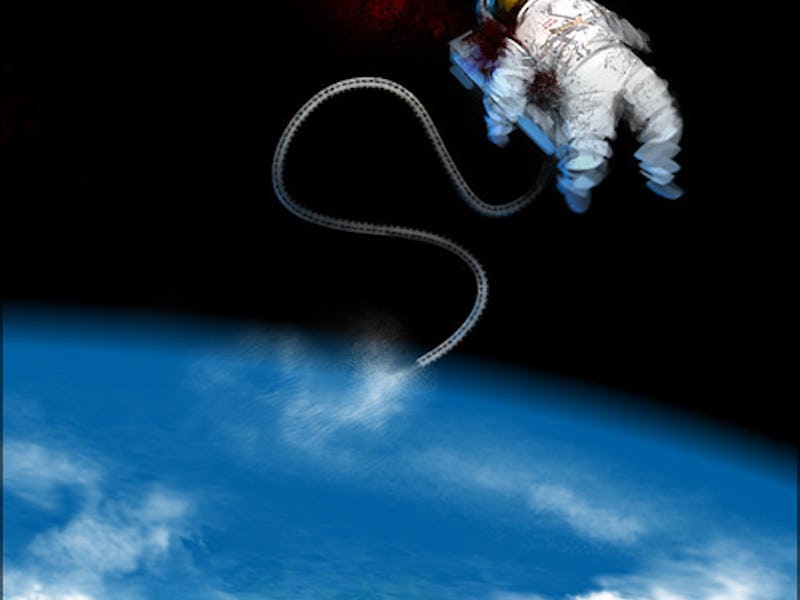Space travel is already terrifying as hell — not least of all when nature calls. Any astronaut who needs to venture out of the spacecraft and into the void has only one substitute option for a space toilet: diapers. These are not exactly the most ideal or sanitary solution.
On Wednesday, NASA and online crowdsourcing platform HeroX announced the winners of its Space Poop Challenge, a global competition to come up with sanitary solutions for human waste management inside a spacesuit. More than 19,000 people submitted over 5,000 solutions.
“The response to the Space Poop Challenge exceeded all of our expectations,” Steve Rader, NASA Tournament Lab Deputy Director, said in a press release. “The level of participation and interest went far beyond what we expected for such a short competition.”
Astronauts may have to wear a spacesuit for up to ten hours at a time during the launch or landing phases, or even up to six days if something catastrophic happens. Diapers are nowhere near meant to be worn for that long. So NASA launched the Space Poop Challenge to develop solutions for a suit that could better deal with the piss and shit that could manifest during unusual or extreme situations.
The rules for the challenge were pretty simple: The space suit must be able to collect human waste for up to six days and route it away from the body without the astronauts having to use their hands. This system must also be able to operate in space conditions and keep the astronaut alive and healthy.
Over 19,000 competitors submitted more than 5,000 solutions to the Space Poop Challenge.
Although NASA won’t directly use the winning solutions, the design concepts of the winning solutions can help NASA create better waste collection systems for spacesuits. The upcoming Orion mission, which will fly in the early 2020s, may be the first to use a spacesuit system to flush away astronauts’ poop.
“It was wonderful to see the global response from our crowdsourcing challenge,” Kirstyn Johnson, Space Suit Technology Engineer at NASA, said in a press release. “We enjoyed seeing the innovative approaches that were sent in given such a demanding scenario. Others at NASA are now thinking about ways we can leverage a crowdsourcing approach to solve some more of our spaceflight challenges.”
Here are the winners:
First Place, $15,000
Winner: Thatcher Cardon
Solution: MACES Perineal Access & Toileting System (M-PATS)
Colonel Thatcher R. Cardon is the first place winner of the Space Poop Challenge.
Colonel Thatcher R. Cardon is Commander 47th Medical Group, Laughlin AFB, Texas. Cardon heard about the Space Poop Challenge through Flipboard, which he uses to follow topics like space and astronomy.
“[I] spent some time lying down, eyes closed, just visualizing different solutions and modeling them mentally,” Cardon said. “Over time the winning system of ideas coalesced. Then I packed up the family and we drove around Del Rio, TX to dollar stores, thrift stores, craft stores, clothing and hardware stores to get materials for mockups.”
Drawing from his experience as a flight surgeon, his design features a hygiene wand, which is covered with tubular fabric and can be used instead of toilet paper, and underwear that resembles a maxi pad and unfolds inside the space suit.
Second Place, $10,000
Winners: Katherine Kin, Stacey Marie Louie, and Tony Gonzales
Solution: Space Poop Unification of Doctors (SPUDs) Team — Air-powered Spacesuit Waste Disposal System
Tony Gonzales is a physician-engineer transitioning to a career in biomedical engineering and biotechnology.
Stacey Marie Louie is an assistant professor in the Department of Civil and Environmental Engineering at the University of Houston.
Katherine Kin is a dentist who does research at the UT School of Dentistry in Houston.
The SPUDs team spent their undergraduate careers studying chemical engineering at the University of Texas at Austin. Now, they’re all doctors (Gonzales is physician-engineer, Kin is a dentist, and Louie is an assistant professor in civil and environmental engineering at the University of Houston). Gonzales introduced his friends to the Space Poop Challenge.
The team proposed an Air-Powered Urine and Stool Handling (Air-PUSH) system that uses natural body movements to carry waste away from the astronaut. The system disinfects and dries the waste while maintaining hygienic conditions.
“We originally joined the competition with the goal of having fun while tackling a unique challenge with friends,” Gonzales tells Inverse. “We are just happy and excited to have the opportunity to contribute our ideas. Hopefully both astronauts and people down here on Earth will be able to benefit as well.”
Third Place, $5,000
Winner: Hugo Shelley
Solution: SWIMSuit — Zero Gravity Underwear for 6-Day Use
Hugo Shelley is the founder of Iota Technology, a London-based design and prototyping company.
Hugo Shelley is the founder of Iota Technology, a London-based design and prototyping company. He has worked on a variety of projects, from industrial sensors to educational robots for children.
“I have been in love with the idea of space travel since I was seven years old, and have always dreamed of working for NASA,” Shelley said. “The thought that my design might be used in a spacesuit is incredibly exciting, and when I heard about the competition through HeroX I felt compelled to join in.”
